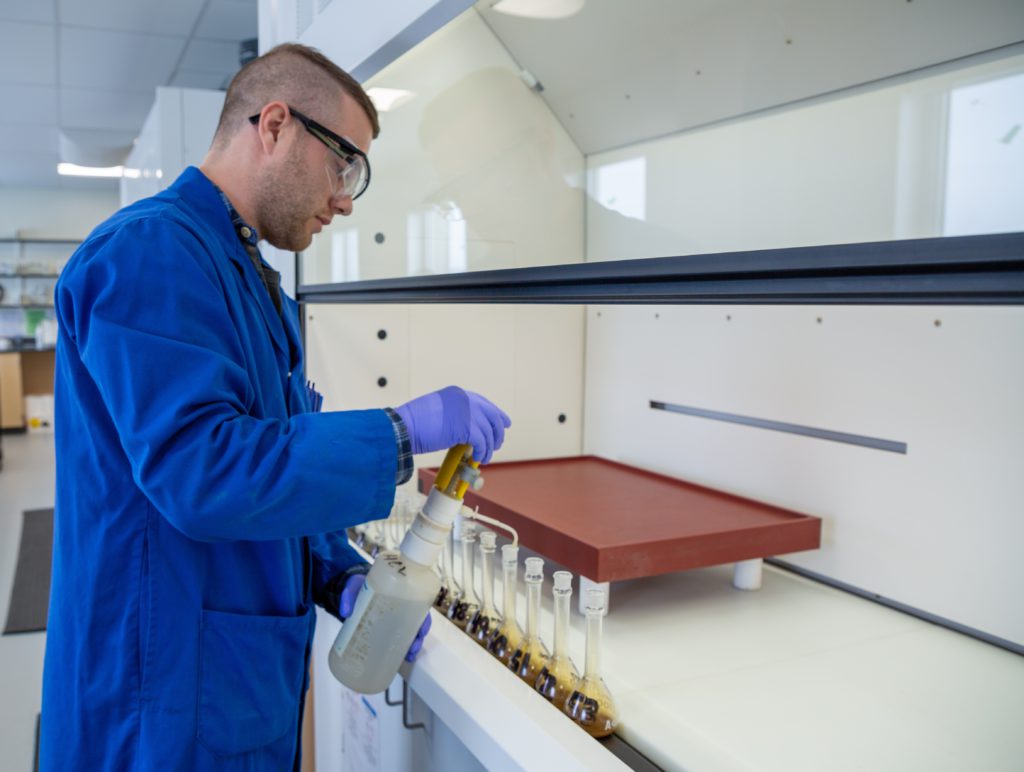
SRC has been a strong steward for Saskatchewan’s environment, with analysis and testing, remediation efforts, and emissions monitoring.
The Saskatchewan Research Council (SRC) has tackled the ever-changing landscape of industry needs since 1947 — finding real-world solutions to evolving challenges through innovation. The organization’s knack for developing new and improved technologies that provide significant value to industry has helped grow both the province’s key resource sectors, as well as SRC’s own labs and facilities.
Bernard Gartner, who recently retired as SRC’s director of strategic growth and business development after a 47-year career with SRC, knows the importance of growing alongside industry. With nearly five decades of experience, Bernard has not only witnessed but also acted as one of SRC’s strongest advocates for how important it is to embrace challenges, develop relationships, and strive to find solutions to complex problems.
In 1978, Gartner walked into SRC’s Geoanalytical Laboratories as a young, eager technician and spent the next 47 years with a front-row view from which he became a driving force in the laboratory’s evolution. It is now the largest lab of its kind in the province, handling geoanalytical testing and automated mineralogy for mining and mineral companies across Saskatchewan and beyond. It also branched off into diamond services and Geoanalytical Laboratories Diamond Services grew into the world’s largest commercial diamond laboratory.
“I watched the Geoanalytical Lab grow over the years from a small team to a large group of experts, who bring a wealth of knowledge to the table and work on developing and optimizing a variety of analyses for Saskatchewan’s exploration companies, all while building relationships and a reputation globally,” said Gartner.
In his nearly five decades at SRC, Gartner has witnessed and led exciting innovations, an influx of experts and professionals, the implementation of leading-edge technologies, and the growth of emerging markets few thought possible — all of which has made SRC one of Saskatchewan’s most valuable assets.
Bread and butter: Saskatchewan’s potash and uranium industries
SRC has been building collaborative relationships with Saskatchewan’s mining and minerals industry since day one, and Gartner has been at the forefront of promoting this over the decades.
“From potash to uranium, SRC was not only built on our expertise in these industries over the years, but also on our approach to relationship building with clients. You need to support clients accordingly and always put the client first. That is what makes SRC different,” said Gartner.
Beneath Saskatchewan’s soil lies the world’s largest — and some of the highest quality — deposits of potash, a naturally occurring compound of potassium salts. This pinkish crystalized evaporite was first discovered in Saskatchewan by an oil company while drilling near Radville in the 1940s. Over the next decade, more potash was discovered across central and south-central Saskatchewan, in what is now known as the “Prairie Evaporite Deposit.”
At the time, the newly minted SRC was less than a decade old, but the Council took to the ground running, conducting field work on potash, building laboratory tests and helping in the development of potash-based fertilizer.
In the 1960s, SRC began to develop potash characterization techniques for the budding industry and worked on projects to improve mining approaches. These have gone on to become worldwide industry standards.
But it was not just potash. Saskatchewan’s rich uranium industry has also been a focus of SRC since the early years. SRC’s first laboratory building included a pilot plant project for uranium separation in 1958, and uranium ore processing has been a reliable service ever since.
With the opening of SRC’s Geoanalytical Laboratories in 1973, work expanded with an influx of skilled geologists and technicians looking for a challenge and seeking new ways to meet and exceed the needs of local and global industries. Many of the methods developed by SRC in the early days of research in uranium analytical techniques continue to be used today.
It was not long after the lab opened that Gartner landed his first job at SRC, where he settled in at the lab bench for two decades working as a junior then senior technician before transitioning into the manager of SRC’s Geoanalytical Laboratories.
Over the years, Gartner led the lab through several expansions, including a high-security facility built for kimberlite indicator mineral processing and diamond recovery to the Advanced Microanalysis Centre to a Dense Media Separation (DMS) Facility.
“If a service was not something we already offered, then it was a good opportunity to explore how we could make it happen, how we could develop those services, and grow with the industry. This remains true of our facilities and services to this day,” said Gartner. His goal has always been growth through value-added services. Gartner’s ability to stay on top of industry trends and turn them into business opportunities at SRC is at the heart of his legacy to the organization.
Digging for uranium and discovering diamonds
Up until the 1990s, diamonds were not part of the Saskatchewan mining and minerals landscape.
“In the 1990s, a uranium exploration company was looking at some anomalies in Fort à La Corne, Saskatchewan, and since SRC was involved with the analysis of their uranium exploration samples, they approached us to look at these samples,” said Gartner. These samples turned out to be kimberlite — a rock that may contain diamonds.
At that time, SRC’s Geoanalytical Laboratories had a minerals separation group that was focused on gold exploration in tills. Since SRC was already separating minerals, it transitioned the group to start focusing on extracting and identifying kimberlite indicator minerals.
The kimberlite discovery in Saskatchewan set off excitement throughout the province and SRC immediately seized the opportunity and the challenge of setting up a kimberlite indicator mineral processing lab.
SRC’s Diamond Laboratory is recognized worldwide for its diamond characterization work.
As exploration increased for kimberlite indicator minerals, and the exploration company initiated a more advanced drilling program, SRC was once again asked to look at the processing of kimberlite core for possible diamonds. To help expand its services, SRC hired an experienced processing engineer who specialized in diamond recovery.
“With a team in place, we proceeded to develop and build a pilot plant to deal with kimberlite core from Saskatchewan. That was the beginning of SRC’s diamond laboratory,” said Gartner.
Rare earth elements (REEs) and beyond
To this day, the potash, diamond, and uranium sectors remain at the heart of SRC’s Geoanalytical Laboratories. As the lab grew, it remained essential for SRC to continue providing services to the exploration industry.
As exploration projects progressed, it soon became clear to the lab that an opportunity existed to provide the next step that the industry needed — a more advanced mineral processing group in Saskatchewan.
“Our diamond lab grew from our uranium expertise, and our mineral processing services grew from the various mineral commodities the lab was involved in,” said Gartner.
The growth of that knowledge and expertise is recognized and acknowledged by industry, which has helped SRC continue to expand its services to different minerals like REEs and lithium.
And without its Mineral Processing team, SRC’s expansion into REEs would not have been possible. SRC’s Rare Earth Processing Facility began as an idea developed by the team, drawing on over a decade of testing REEs’ processing technologies through small, pilot-scale equipment, and in-depth knowledge of the industry in Canada and its needs.
The future of sorting test work
SRC’s venture into diamonds helped grow its expertise, including the testing, piloting, and operation of sensor-based sorting technology. This expertise led to diversification into the application of sorting for other commodities, combined with key collaborations with manufacturers and the launch of SRC’s Minerals Liberation Sorting Centre.
Along with sorting capabilities, SRC has developed testing facilities for preconcentration services, including its Dense Media Separation (DMS) Bulk Sample plant — one of the only continuous testing DMS facilities in Canada that can process a variety of commodities.
Gartner’s focus on client relationships was instrumental in getting the DMS facility up and running. In discussions with several companies, Gartner identified that clients lacked the facilities necessary for large volumes of bulk samples. These talks led to SRC managing the installation of a DMS bulk sample plant, working closely with support from industry clients and manufacturers.
Since then, SRC has evolved to offer a full suite of sorting services and solutions with a three-stage sensor-based sorting test method to help meet the evolving needs of the mining and minerals industry.
An unwavering commitment to solving industry challenges
Over its lifetime, SRC has been a strong steward for Saskatchewan’s environment, with analysis and testing, remediation efforts, and emissions monitoring. In the last decade, SRC has reached significant milestones, expanding its services into sustainability and energy transition.
“In my years at SRC, we try to never say no to a challenge. Our ability to work through challenges and to be nimble and client-focused at every step of the project is what makes SRC unique and one of Saskatchewan’s biggest assets,” said Gartner. 
To learn more about SRC’s full suite of mining services, visit src.sk.ca.




